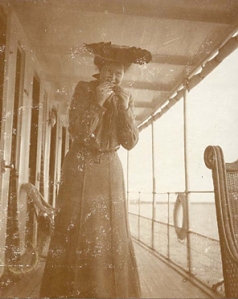JANUARY 1904 – EGYPT “This fascinating Eastern land!”
January 1904, Marjorie and Helen Macartnay left Italy to begin their long journey to Cairo – a long train ride to Brindisi; a steamer to Alexandria; and then another train to Cairo. Marjorie’s first impressions of the country were from the train window, of cotton fields, rich green grass, and deep blue skies. “The trees we passed were tall stately date palms, grey-green mimosas, and lebbecks with locust-like leaves and bright yellow pods. There were poinsettias – great tall ones, and a plant with stunning crimson flowers, the bougainvillea. At one side of us at a little distance was the grand old Nile, and along the tow-path passed a never-ending stream of camels laden with great sacs of cotton.”
In Cairo they were met by a representative from the famous Shepherd’s Hotel who took them through the busy streets to the hotel. Marjorie describes “A jumble of curious sights and sounds, scarlet tarbushes everywhere, black-robed women, and donkeys braying.” On the first afternoon they had tea on Shepheard’s terrace, right over the street, where it was said that if you sat long enough you would see the world go by. Marjorie wrote to her mother, “I never sat long enough!” She did sit long enough, however, to see vendors “crying their wares and offering to sell you monkeys, post cards, pipes, fly brushes, ostrich plumes, embroideries, scarabs, donkey beads, inlaid boxes, and crocodiles! There are groups of tumbling acrobatic children, and dragomen eager to show you the sights and water carriers with skins full of water, and men with huge stone or glass jars of lemonade and in their hands two little brass bowls for you to drink out of which they keep clinking together to make you know they are there.” On the terrace itself there were exquisitely dressed people to watch, English, American, French, German, Turkish, and Syrian.
The next day they visited the Bazaars – narrow streets lined with shops. “In front of each shop was the shopkeeper sitting cross-legged on a broad shelf – useful alike for counter, couch, and table – and smoking his long cocoanut bowled ‘nargileh’ [or waterpipe]. The shops themselves were hung with bright shawls and carpets and offered for sale a fascinating variety of bracelets, beads, embroidered jackets, slippers, and wares of silver and brass.” Marjorie was fascinated with the spice bazaar where herbs and medicines were being prepared in stone mortars. And the perfume shops where they sold attar of roses and incense. But the silk shops were the most interesting, “…where scarfs were being woven by busy hands and feet. And when they have a big thing like a carpet to do, they stretch their looms right out into the street and then run up and down with a huge shuttle shaped like a parasol made of bamboo.” They also visited the brass bazaars, and the silver and goldsmiths. All accompanied by young girls singing and playing their tambourines.
They hired their own Dragoman (a local guide) to accompany them to the Mosques. His name was “Mohammed Brown” and he showed them all the interesting places in the city, and to the Pyramids. Marjorie climbed the largest of the three, and commented that it was quite a climb, “But oh! The view is worth it.” From the top she could see the sphinx, “her proud head almost hidden by the sand hills – and beyond the great flat nothingness of the dessert stretching in waves of pinkish yellow sand to the horizon. On the other side it was all so totally different, for there the wonderful old Nile held sway and the country was green with foliage and dotted over with date palms…I could have stayed forever looking at this twofold view.”
 The Great Sphinx, partly covered by sand
The Great Sphinx, partly covered by sand
The next part of the tour was a week-long trip down the Nile on the famous paddle steamer “Rameses the Great.” The boat carried 78 passengers. Marjorie and Miss Macartnay had secured the best rooms on the upper deck, on the sunny side, near the large outdoor sitting room with easy chairs and a piano where all the passengers gathered in the afternoons for tea. “In the evening, the light grew better and the hills began to wear their lovely mantels of purple. [later in the evening] the moon was out, and as I looked from my cabin window, the whole river was flooded with a ghostly silver light and the palm trees on the opposite shore lent their reflection to the water…we could indeed feel that we were in ‘beautiful Egypt.’”
Marjorie on board “Rameses the Great” 1904
Each day there were different excursions, the most beautiful being to the temple of Athor, the Egyptian Venus, begun by the Ptolemies and finished and embellished by Cleopatra. It was later restored by the Roman Emperors. “Our first glimpse was of a great triumphal arch, and then suddenly the grand temple itself rose above the sand hills…the wonderful grandeur of the façade came up on us – with its rows of massive columns. Each column was covered with hieroglyphics and bore a representation of the goddess Athor. As we passed into the semi darkness of the grand hall of columns the centuries seemed to roll away and we were again back in the days of the Ptolemis. But alas there were no processions of priests, no crowds of awe-inspired spectators, only a handful of peering tourists and some birds flying in and out among the forest of pillars and breaking the stillness of the ages with their song.”

